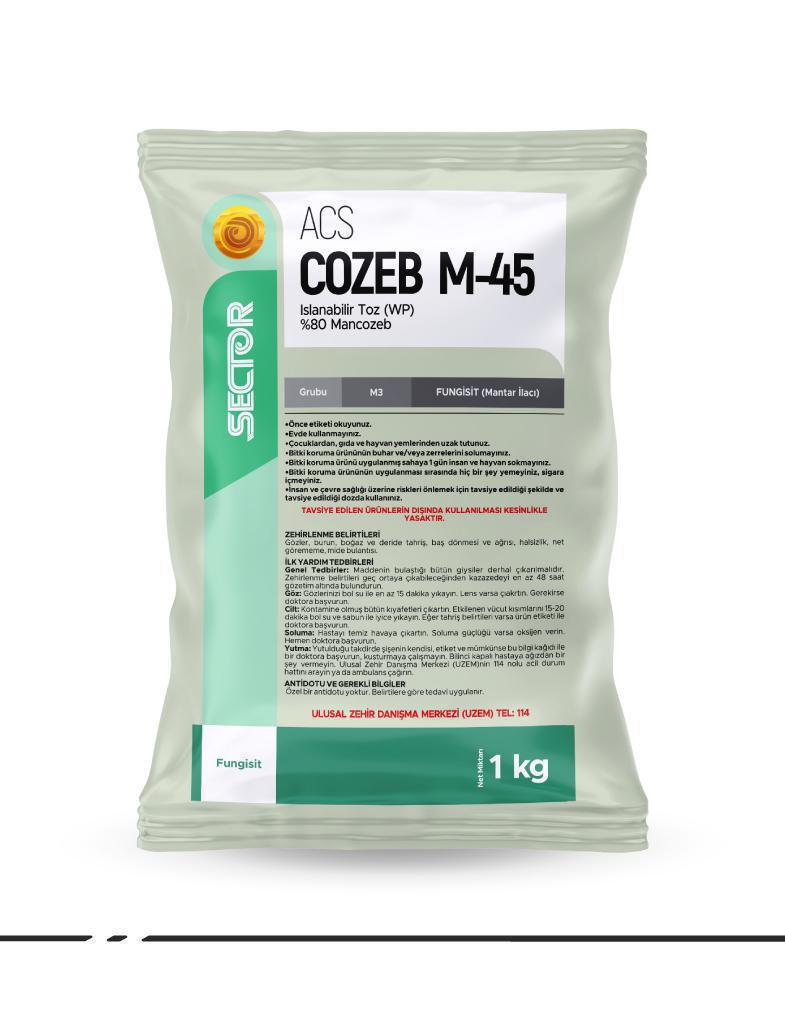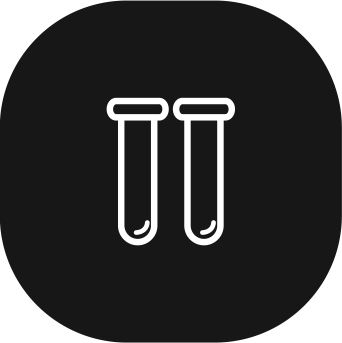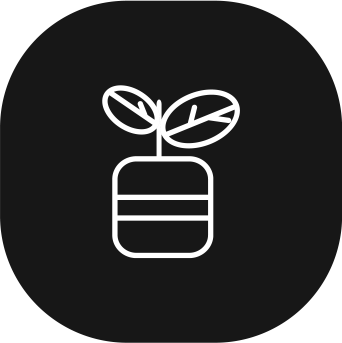
ACS Cozeb M-45
Category: Crop Protection
Product Group: Fungicide (Fungicide)
Active Agent: % 80 Mancozeb
Formulation: Wettable Powder (WP)
APPLE SCAB: 1st spraying: When the buds swell (3-5 days ago for the areas where there are lesions on the branches) 2nd spraying: During the pink flower bud period (when the flowers are seen separately.) 3rd spraying: When 70-80% of flower petals fall off 4th and other sprayings should be carried out taking into account the effectiveness of fungicides used, if climatic conditions are suitable for the progression of the disease. TOMATO DOWNY MILDEW: Spraying begins when a white ash-like coating is visible under the 3-5 mm diameter brown spots on tomato leaves, or when the disease occurs when suitable conditions for the disease are seen. Spraying continues at 10-12 day intervals depending on the course of the disease and climatic conditions. APPLE RUST FUNGUS: 1st spraying: After bud break (beginning of the red flower period) 2nd spraying: when the flower petals fall off completely 3rd spraying: It should be carried out 15 days after the second spraying. GRAPEVINE DOWNY MILDEW: The first application should be made when the shoots have reached 25-30 cm. The second and subsequent sprayings are carried out at 10-15 day intervals, taking into account the duration of the first spraying, the development of the disease and the meteorological conditions. PHOMOPSIS CANE AND LEAF SPOT: Summer spraying 1st spraying is carried out when the shoots are 2-3 cm 2nd spraying is carried out when the shoots are 8-10 cm 3rd spraying is carried out when the shoots reach 25-30 cm. ONION DOWNY MILDEW: Even if it is necessary to start the control when the daily average temperature reaches 160C and the proportional humidity reaches 80%, spraying may begin when the first signs of disease are seen around. DOWNY MILDEW ON CUCUMBER, CUCURBITACEAE: Spraying begins when plants begin to branch or when the first symptom of downy mildew appears and continues at 7-10 day intervals, depending on the severity of the disease. It should be sprayed so that all parts of the plant are covered, especially under the leaves. TOMATO DOWNY MILDEW: Spraying begins when a white ash-like coating is visible under the 3-5 mm diameter brown spots on tomato leaves, or when the disease occurs every year when suitable conditions for the disease are seen. Spraying continues at 10-12 day intervals depending on the course of the disease and climatic conditions. CHICKPEA ANTHRACNOSE Seed spraying: It should be applied on the day of sowing. Green part spraying: Even if it is necessary to start the spraying when the daily average temperature reaches 16 oC and the proportional humidity reaches 80%, it should be started practically when the first signs of the disease are seen in the region. Spraying should continue depending on the severity of the disease, climatic conditions and effectiveness of the fungicide. If it rains heavily on the day of spraying, the spraying should be repeated. BEAN ANTHRACNOSE: Spraying begins when the first symptoms of the disease appear in the region. Spraying should continue depending on the severity of the disease, climatic conditions and effectiveness of the fungicide. Strict care should be taken to spray all green parts of the plant. BEAN RUST: Spraying should begin as soon as rust pustules are seen on the leaves of bean plants around, and spraying should continue depending on the severity of the disease, climatic conditions and effectiveness of the fungicide. If the disease occurs at maturity of capsules of dry beans, spraying is not necessary because it does not cause economic losses of product. TOMATO, EGGPLANT, POTATO EARLY BLIGHT: Spraying should begin as soon as the first signs appear, both in the nursery and in the field. If the climatic conditions are suitable for the development of the disease, spraying continues at 10-12 day intervals depending on the course of the disease and climatic conditions. DAMPING OFF AND ROOT ROT IN VEGETABLE SEEDLINGS: The seeds are sprayed before sowing by mixing 200 g of fungicide per 100 kg of seed. METAL WATERMEON ANTHRACNOSE: Seed spraying: The seeds are soaked for 1 hour and dried for 1 hour, then spraying is carried out before sowing. Green part spraying: Even if it is necessary to start the control when the daily average temperature reaches 16 C and the proportional humidity reaches 80%, the most practical way in application is to start spraying with the detection of the first anthracnose spots on the leaves and stems of melon and watermelon plants. Spraying should continue depending on the severity of the disease, climatic conditions and effectiveness of the fungicide. WHEAT RUST DISEASES: Spraying should begin when symptoms of yellow rust Puccinia striiformis, brown rust P.recondita tritici, black rust P.graminis tritici are seen. Green parts are sprayed against rust factors. Spraying should be carried out so that the surfaces of the leaves and stem are covered with the spray. Spraying continues at 21-28 day intervals if necessary, depending on climatic conditions and the state of the disease. Spraying should be carried out from the entry of the plant into maturity one month before harvest. HOP DOWNY MILDEW: Spraying begins when the shoots reach an average of 75-100 cm in the spring. It is repeated every week until the flowering period. From this period to the boll formation period, it is continued at 10-day intervals. CROWN ROT DISEASE IN PEANUT: It is seed spraying. The seeds are moistened before spraying so that the fungicide can adhere to the seed surface. PEANUT LEAF SPOT: Spraying begins after 4-5 weeks in areas where the disease is seen every year. It should continue until harvest.
| PLANT NAME | HARMFUL ORGANISM NAME | APPLICATION DOSAGE | TIME BETWEEN LAST APPLICATION AND HARVEST |
| FRUITS | Scab (Venturia inaequalis) | 250 g/100 L. water | 21 days |
| Apple | Rust fungus (Gymnosparangium confusum.) | 250 g/100 L.water | 21 days |
| Vineyard* | Phomopsis cane and leaf spot (Phomopsis viticola) | 20 | 21 days |
| g/100 L | |||
| water | |||
| Downy Mildew (Plasmopora viticola) | 200 g/100 L. water | 21 days | |
| Onion | Downy Mildew (Peronospora destructor) | 200 g/100 L. water | 28 days |
| Cucumber | Downy Mildew on Cucurbitaceae | 200 g/100 L. water | 14 days |
| (Pseudoperonospora cubensis) | |||
| Tomato | Downy Mildew (Phytophthora infestans) | 200 g/100 L water | 14 days |
| Chickpea | Anthracnose | 200 g./100 L. water | 28 days |
| (Ascochyta rabiei) | 200 g/100 kg. seed | - | |
| Anthracnose | 200 g/100 L. water | 28 days | |
| (Colletotrichum lindemuthianum) | |||
| Bean | Rust (Uromyces appendiculatus) | 200 g/100 L. water | 28 days |
| Tomato, Eggplant, Tomato | Early Blight | 200 g/100 L. water | 14 days |
| (Alternaria solani) | |||
| Seedling Root Rot (Damping Off) | |||
| Vegetable Seedlings | (Pythium spp, Fusarium spp, Rhizoctonia spp, Alternaria spp, Sclerotinia spp.Phytophthora spp.) | 200 g/100 kg. seed | |
| - | |||
| Melon, Watermelon | Anthracnose (Colletotrichum lagenarium) | 200 g/100 L. water | 7 days |
| Wheat | Rust (Puccinia spp.) | ||
| Yellow rust (Pucinia striiformis) | |||
| Brown rust (P. recondita tritici ) | 350 g/da | 28 days | |
| Black rust (P. graminis tritici ) | |||
| Hop | Downy Mildew (Pseudoperonospora humuli) | 150 g/100 L.water | 42 days |
| Leaf Spot | 200 g/100 L. water | 14 days | |
| Peanut | (Cercospora arachidis) | ||
| Crown Rot Disease | 500 g/100 kg seed | - | |
| (Aspergillus niger) |


 Türkçe
Türkçe  English
English  Russian
Russian  Arabic
Arabic  Germany
Germany  French
French  Spanish
Spanish 








